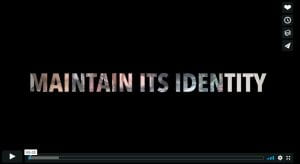Research in Fine Arts
Picturing the Defiance of Street Vendors Against the Rise of Industrialization and Corporatization in the Philippines
By Bhen Alan

Portrait of Bhen Alan at work in the Philippines
I am a Senior Art and Design Major with a Painting concentration in the College of Visual and Performing Arts at UMass Dartmouth. My passion for painting is not just for aesthetic reasons. I want to use art to give a voice to the voiceless. I also want to address current socio-political events. Last spring I was a recipient of a (2018) summer stipend from the Office of Undergraduate Research. The goal of the research was to create a body of work about the rising tension between different classes due to rapid corporatization and industrialization in the Philippines. This topic has become a politicized issue since I moved away from the Philippines. Until I was a teenager, I lived in the Philippines and then moved to Canada before settling in the United States. I feel fortunate, because immigration has given me the opportunity to skip the economic crisis that has affected my hometown. However, the culture of the people who make a living in the Philippines is something that I have always loved and respected.
I conducted my research in Tuguegarao City, located in the province of Cagayan. The region is a 12-hour-drive from Manila. This is the city where I was born and raised by my grandmother who is a vendor. Although, Tuguegarao City is not a big municipality in terms of geographical area, the rise of industrialization, corporatization, and globalization is affecting its economy. During the administration of the former mayor, Delfin Ting in 2011, he re-built the old public market in downtown Tuguegarao. He named it the “Mall of the Valley.” This establishment was meant to organize all of Tuguegarao City’s street vendors. It was meant to provide protection and to fix the problem of traffic congestion. Unfortunately, in order for the street vendors to have access to a retail space in the building they had to pay a monthly retail space, provide a business permit, and register at the Bureau of Internal Revenue (BIR) for business taxes. However, the street vendors who sell seafood, meat, produce, flowers, and other goods are incapable of paying these high taxes. Moreover, they cannot afford to own a retail space. For these reasons, street vendors still gather on the sidewalks of the streets of Tuguegarao City. As a result, most retail spaces in the “Mall of the Valley” are now abandoned, and street congestion still remains a big issue because of this situation.
§

Street vendors flock beside the Mall of the Valley building
As of 2017, large mall operators have emerged throughout the city proper. SM Supermalls and Robinsons Malls, which are the largest malls in the Philippines and Southeast Asia have also entered Tuguegarao City’s territory. The rise of corporatization, industrialization, and globalization in the city is very important for the economy because the city is becoming the center for commerce, industry and service for the Cagayanos. Globalization and industrialization is largely a good thing since it lifts both actual and imaginary boundaries. It brings us closer to each other. However, globalization also makes it hard for a culture to maintain its identity. So, how does a culture maintain its identity while keeping up with the advancement of the modern world?

Robinsons Place Mall under construction for a 60,000 sq. m. floor area making the biggest mall in Tuguegarao City
That is the question I kept asking during the course of my painting research, which involved ethnographic work. The body of work I produced focuses on the city’s lively and energetic streets because of hardworking locals who work from dusk to dawn to bring liveliness and dynamism to the city. My paintings showcase the street vendors who sell their locally grown goods, thus competing with the rise of globalization and corporatization in Tuguegarao City. The local vendors are able to maintain our tradition and practices through local marketing while the city is able to keep up with the modern advancements. The duality our city is offering is very important for the economy. Despite this idyllic description, Tuguegarao faces many multi-dimensional challenges of poverty. During my first excursion to the public market, I unexpectedly met Elsid Natividad who is a Capitol officer who gives “arkabala” or a cash ticket that serves as a market fee to the street vendors. Since a new mayor, Jefferson Soriano, is now running the city, one of his policies is allowing vendors to sell their goods and products in certain areas. They do not need to have a business permit or apply to the Bureau of Internal Revenue, they just need to clean up their spaces at the end of the day and pay “arkabala” which costs 10 pesos or .20 cents (USD). This serves as their daily tax for using a 1×1 meter space. The tax goes to the government for public funds. If they exceed a 1×1 meter retail space, their “arkabala” will be doubled or tripled. Unfortunately, since large malls and big supermarkets are competition, some street vendors are unable to pay the market fee because of lack of customers. Their last resort is to pack up their products and leave the space before the officer gives them a ticket. But some street vendors are also successful as the informal sector of the society.

Cash Ticket or Arkabala serves as the daily taxes of street vendors. It cost 10 Philippine pesos of .20 cents U.S. dollars
Products like garments, accessories, and even appliances may not sell well in the streets, but any kind of edible material is a big hit. Filipino customers bargain their prices to get a product cheaper, which is why they prefer to buy their meat, seafood, and produce outside supermarkets according to Alice Rioja, a seafood vendor in the street of Tuguegarao. She proudly claimed that customers buy more of her seafood products and reject the supermarkets because of their fixed and expensive prices. In their street space, which is one of the biggest spaces in downtown, customers can bargain the prices even lower and get the fish almost for free. The process may not look as clean as the supermarket’s but the quality of the product is the same. Filipinos generally gravitate to a greater quantity that fits the budget rather than buying expensive products that is packaged cleanly and safely yet have a smaller quantity.

Bhen Alan during a work in progress of 4×5 feet painting

Alice Rioja posing in front of her seafood products in Downtown Tuguegarao
Unlike Alice Rioja who is a successful seafood street vendor, Filomena Iquin, an 84-year-old produce vendor, struggles to sell her vegetables. By her own account, she harvests some of the vegetables in her backyard and brings them to the market to sell. She sometimes buy vegetables from another vendor then sells them at a higher price. Unfortunately, she is not always able to sell everything because of her competitors, and then she is unable to pay the market fee. She said if she couldn’t pay the market fee the day I interviewed her, she will be temporarily banned for three days to sell her products.
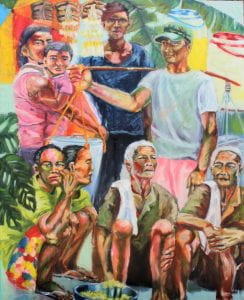
How can we maintain our cultural identity | oil on canvas| 4 feet by 5 feet
I also met a lone bamboo shoot (rabung) vendor who refused to give her identity. She struggles to sells her product. The drama of her posture and the colorful background against the greyness of the drugstore building is the reason why I chose to paint the scene. A family of mango vendor accepted my request to take their pictures amidst the busiest street in the Philippines, Edsa. By their own account, they are not allowed to place their cart in the streets but they have to do it to earn a living. This is a good contrast between conformity versus rebellion. I love how they bring color to the crowded and dullness of the street even though they know the consequences if they get raided.
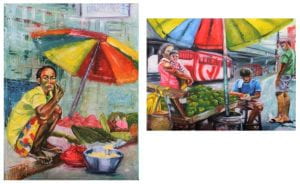
Left image: Drugstore at Del Rosario Street. Right image: Fresh Harvest | oil on canvas | 3feet by 4 feet
Industrialization, globalization and modernization may be happening around the city but these street vendors bring visual vibrancy and maintain the cultural practice that the Filipino people has been practicing. The flow of traffic might be congested under the brisk bare light of Tuguegarao, but people are getting used to it. The government is still fixing the traffic problem as vendors are taking over some parts of the streets, but at least there is now a law that protects these vendors. Street Vending is legalized under the Executive Order 452 as part of the Social Reform Agenda of Government.
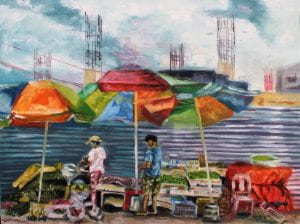
Three Umbrellas | oil on canvas | 2 feet by 3 feet
A cultural forum was held during my stay in the Philippines. It was a whole day program held in Tuguegarao City to talk about the preservation of the culture of Ybanag (people of Tuguegarao) while modernization is taking over. I was invited as a guest speaker to talk about how my paintings maintain the culture of Ybanags, how it touches industrialization, and how it promotes the Filipino culture in the United States. Other guest speakers talked about the roles of indigenous people, the significance of local cultural heritage, issues and concerns about tangible and intangible heritage, and promotion of local heritage. All the themes were very relevant to my research. The event gave me an opportunity to dig deeper in my culture. Sadly, my culture, Ybanag and Itawes, is slowly vanishing because of rapid industrialization. The cultural forum did not only give me resources to finish my research, but it also allowed me to use it as a platform to present my paintings and promote my heritage.

Left image: coordinators, guest speakers, teacher of Linao National High School after the cultural forum. Right image: Bhen Alan during his art talk about promoting culture through visual arts
My project was divided into two parts: the first part was to accomplish my research about the rising tension between classes due to industrialization, and the second was to visit local schools to introduce the exciting possibilities of contemporary arts. I chose schools that lack resources necessary to teach a hands-on based studio project. Also, because of poverty, most students do not have opportunities to see an art show or to listen to a local artist. A lot of students are really talented in art, they have potential, but being an artist in the province is not considered a serious profession.
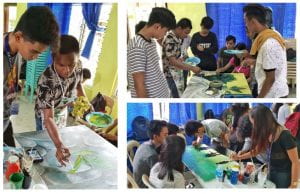
Students of Linao National High School during their 2-day art workshop
§
Art offered me a platform to give students the experience and information about our cultural heritage. The Philippines is very rich in visual arts but not everyone can access it. People living in the barrio do not have a chance to experience visual arts or even use any artistic materials because of poverty. Food is prioritized over expensive art supplies. Given this, I provided all the materials needed – paints, brushes and hand stretched canvas – so that students would not spend any of their allowances. The first school that I visited was at Linao National High School in Tuguegarao City; it was my 2009 Alma Matter. Going back to conduct a workshop is my way of giving back to the school and the community. A 2-day workshop was held to grade 12 TVL (technical-vocational-livelihood) students. I chose this group because they specialize in hands-on based activities. It was an all-day workshop from 8:00 am to 4:00 pm. During the first half of day one, a power point presentation about my life abroad, my purpose on going back to the Philippines, being a student at the University of Massachusetts Dartmouth, a slide-show of my portfolio and examples of contemporary artworks and artist were presented. Mr. Alejo Cambri, Art and Design Teacher, divided the class into 4 groups since there were 40 students. Each group had their own painting category to create: still life, plein air, silhouette painting, and illustration focusing on tropical designs about localization. The students started gathering their ideas, photographing, sketching and started painting on the second half of day one. The morning of the second day was intense because we only had the half day to finish the works. We even made it more intense when we decided to make it a competition to motivate students to take the workshop more seriously. I saw how they were collaborating to mix colors, they were helping each other to render shapes and forms and to finish their projects. It was challenging for them because it was their first time using acrylic paint on a canvas. It was also their first time to collaborate. I had to roam around the room and help each one with how to apply paints; some students have their own techniques and styles, but others did not know the proper use of the materials. It was challenging but rewarding when we finished the projects. A fun program was made as we concluded the workshop. I provided snacks to the kids and we set up the room as if it was a gallery. We invited teachers to judge the paintings, the principal and the head teacher were also present, and other students were also invited to observe the program and they interviewed me for their school paper. My objective for the closing program was to teach students how to critic: how to present their artworks and critic their peers in basic yet artistic and an academic way. Each group had a representative to present their artworks as the judges and other students gave their insights and opinions. I also displayed my paintings beside the students’ outputs. I had the chance to present my research and answer a few questions about it. To close the program, a certificate of participation was given to all participants, a certificate of recognition and a print of my artworks were given to the winners, and a certificate of appreciation was given to Mr. Alejo Cambri and to all judges. Their final paintings went on display throughout the campus to serve as public art.

Plein Air group and Still-Life group with their final paintings

Tropical Illustration group and Silhouette group with their final paintings
The second school that I visited is Cagayan National High School in Tuguegarao City. There were 61 art and design students who participated. Unfortunately, I ran out of funds to provide materials but the art and design department helped me. We created a simplified self-portrait using black and white acrylic paint. I was inspired by my design class projects and decided to pass the knowledge onto the students. My objective in this workshop was to teach them how to control their use of shading and gradation. Also I aimed to introduce portraiture on a simplified form where details aren’t the important part of the portrait but the general shape and plane are what makes a portrait sophisticated. Also to show them a different approach to teaching art and to reciprocate our knowledge with each other. A certificate of appreciation was given to me by the department during the closing program.
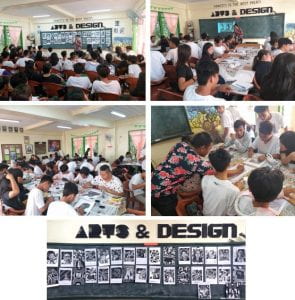
Cagayan National High School Students during their art workshop working on a simplified self-portrait
Subsequently, I traveled a 12-hour-bus ride from Tuguegarao City to Manila, then a 2-hour-plane ride from Manila to Tagbilaran, Bohol where the third school that I visited is located. Another 4-hour-bus ride from Tagbilaran to Talibon City was needed to reach the school San Isidro Elementary School. My colleagues and I decided to visit this school because of their lack of art classes and poverty. They were very hospitable despite their poverty. We coordinated with Ms. Frozen Abedejos, a grade 4 teacher to accomplish the workshop. She gathered 20 students from kindergarten to grade 6 to participate in the program. Later on, most of the population of the school joined us to experience our watercolor lesson. I decided to teach watercolor to the students because they did not know what the material was; they had not touched a watercolor set before. My objective for this workshop was to introduce the possibilities of the medium and let students experience the watercolor itself. There weren’t any rules that they needed to follow, I just showed a few techniques and let them enjoy the workshop. Later, I learned that the schools wanted to join an art contest. So I taught the competitors the proper use of watercolor; the techniques and styles that can be used to prepare the students for the competition were employed. Because of poverty, an outreach program was also made for the kids. Since we do not have enough fund to provide school supplies, we solicited Procter and Gamble employees in Manila. We bought papers, notebooks and pencils to give to the students. They thought they had to pay for these materials, but when their teacher explained that it was a donation, they were all excited and grateful.
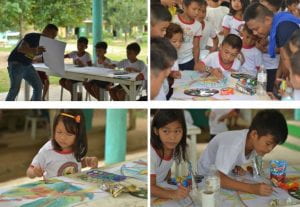
Students of San Isidro Elementary School during their watercolor workshop
During the process of my research, I was invited for a solo art exhibition that took place in conjunction with the celebration of Aggao Nac Cagayan, the annual province’s festival. Since there are no galleries in the Tuguegarao City, it was held in a mall; at SM Tuguegarao Downtown. It was ironic how my paintings dealt with the rise of the corporatization, and then they were exhibited at one of the largest malls in the Philippines. However, the exhibition gave me the opportunity to display and talk about my artworks to a larger audience – to show the millennial audiences how this culture is battling for its sense of identity. The show was exhibited at the center of the mall so that everyone would see it. It was displayed for a day during the festival. I used this pop-up exhibition as a platform to interact with the people and communicate with them about the issues that I am concerned about. Most people told me that industrialization and corporatization is a good thing for the city because it provides a lot of resources for the people. They are able to use transportation that is easy to access like Uber and Grab and there are also increasing business profits that are happening in the city. I also asked people how to maintain our culture since industrialization and corporatization is rising to ensure our values, practices, heritage and sense of continuity is preserved. Most answers that I received were related to the theme of keeping customs alive and helping organizational methods that protect the culture. It was heartwarming when most people appreciated the visual presentation of the street vendors in my paintings because it is a valuable asset for the city.
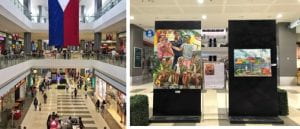
Bhen Alan’s Artworks in the center of the SM mall in during a pop up exhibition
My research allowed me to explore a different style of painting. Before this research I used to paint only photo-realist works. I romanticized overly detailed paintings as I meticulously rendered every single micro detail of a subject. The paintings that produced for my research is a huge leap from photo-realism. I allowed myself to be free, loose and painterly. I show my underlying structures, my brush strokes are visible and uncontrolled. I even moved my body as I painted on a large sized canvas. These paintings are very spontaneous. This research improved my skills as an artist as well as a researcher. I am grateful to the OUR and to my advisor, Professor Suzanne Schireson, for helping me throughout the course of this research.
§
To learn more about my work, click on the following images to see footage made during my OUR funded fieldwork in the Philippines:



